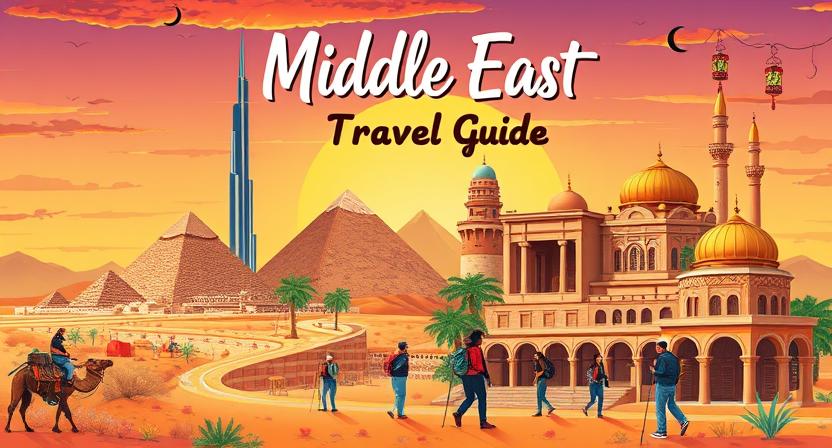
Middle East Travel Guide
The Cradle of Civilization
The Middle East is a region of profound historical importance, cultural richness, and breathtaking landscapes. From the bustling bazaars of Istanbul to the ancient ruins of Petra, and the pristine deserts of Oman to the skyline of modern Dubai, this region offers an extraordinary blend of past and present. Its diverse destinations appeal to history enthusiasts, adventure seekers, food lovers, and luxury travelers alike.
Best Time to Visit the Middle East
The best months to explore the Middle East are October through April, when temperatures are milder. Countries like Jordan, Egypt, Lebanon, and Iran bloom with life during spring and autumn. Avoid peak summer in desert nations such as Saudi Arabia and UAE, as temperatures can soar above 45°C (113°F).
Top Destinations to Discover in the Middle East
1. Dubai, United Arab Emirates – The Future in the Desert
Dubai is a symbol of modern luxury and architectural marvels. The Burj Khalifa, the world’s tallest building, and the Palm Jumeirah, a man-made island, define its skyline. Visitors can shop at the Dubai Mall, enjoy desert safaris, dine at Michelin-starred restaurants, and explore cultural gems like Al Fahidi Historical District.
2. Petra, Jordan – The Rose City of Antiquity
One of the New Seven Wonders of the World, Petra is carved entirely from rose-hued rock. This Nabataean archaeological site, with its iconic Treasury, Monastery, and Siq canyon, offers travelers a glimpse into ancient engineering and architectural brilliance. For a magical experience, visit Petra by Night.
3. Jerusalem, Israel – Sacred Ground for Three Faiths
Jerusalem is revered by Jews, Christians, and Muslims, making it one of the most spiritually significant cities on Earth. Must-see sites include the Western Wall, Church of the Holy Sepulchre, and the Dome of the Rock. The city’s Old City quarters are steeped in thousands of years of living history.
4. Istanbul, Turkey – The Crossroads of Continents
Straddling Europe and Asia, Istanbul boasts an unrivaled blend of Eastern and Western cultures. Explore the majestic Hagia Sophia, the Blue Mosque, and the Topkapi Palace. Wander through the Grand Bazaar, savor Turkish delights, and cruise the Bosporus Strait for unforgettable views.
5. Muscat, Oman – Authentic Arabian Beauty
Unlike its glitzy neighbors, Oman offers authentic Middle Eastern charm. In Muscat, travelers can explore the majestic Sultan Qaboos Grand Mosque, visit the Royal Opera House, and relax on pristine beaches. A road trip through the Wadis, Hajar Mountains, and the Wahiba Sands Desert is essential for nature lovers.
6. Cairo, Egypt – Gateway to the Pyramids
Cairo is a bustling metropolis steeped in Pharaonic legacy. The Pyramids of Giza, the Sphinx, and the Egyptian Museum are just the beginning. Explore vibrant neighborhoods like Zamalek and shop in the ancient Khan El Khalili Bazaar. Don’t miss a cruise down the Nile River.
7. Beirut, Lebanon – The Paris of the Middle East
Beirut is known for its rich culture, vibrant nightlife, and Mediterranean beauty. The city boasts a sophisticated culinary scene, historical ruins like Byblos and Baalbek, and charming coastal views. Lebanon’s mountains are perfect for hiking and skiing, just a short drive from the capital.
8. Doha, Qatar – Rising Cultural Giant
Doha is quickly emerging as a cultural powerhouse in the Gulf. Visit the Museum of Islamic Art, admire futuristic architecture in Msheireb Downtown, and walk the Corniche at sunset. Traditional souqs like Souq Waqif offer a contrast to the city’s modern luxuries.
Cultural Etiquette and Travel Tips
-
Dress modestly, especially in conservative areas or when visiting mosques.
-
During Ramadan, avoid eating or drinking in public during daylight hours.
-
Respect local customs, greetings, and religious practices.
-
Bargaining is common in markets—don’t accept the first price.
-
Always carry some local currency, even in digital-friendly cities.
-
Learn basic Arabic phrases, such as shukran (thank you) and marhaba (hello), to enhance your experience.
Culinary Highlights of the Middle East
The Middle Eastern culinary scene is rich and diverse. Here are must-try dishes:
-
Hummus and Falafel – Staples across the Levant.
-
Mansaf (Jordan) – A lamb dish with fermented yogurt sauce.
-
Kabsa (Saudi Arabia) – Fragrant rice with meat and spices.
-
Kebabs (Iran, Turkey, Lebanon) – Grilled meats marinated with bold flavors.
-
Baklava (Turkey, Syria) – Layers of filo pastry, nuts, and syrup.
-
Mezze Platters – A selection of small dishes perfect for sharing.
Adventure Experiences for Thrill-Seekers
-
Wadi Rum Jeep Tours (Jordan) – Navigate Mars-like red sand landscapes.
-
Hot Air Ballooning in Cappadocia (Turkey) – Iconic views over fairy chimneys.
-
Scuba Diving in the Red Sea (Egypt) – Explore coral reefs and wrecks.
-
Dune Bashing in the Empty Quarter (UAE, Saudi Arabia) – Ride over towering sand dunes.
-
Hiking Jebel Akhdar (Oman) – Discover ancient terraces and panoramic peaks.
Historic and Religious Pilgrimage Sites
-
Mecca and Medina (Saudi Arabia) – Holiest cities in Islam (open only to Muslims).
-
Mount Sinai (Egypt) – A revered location for Abrahamic faiths.
-
Ur (Iraq) – The legendary birthplace of Abraham.
-
Qom and Mashhad (Iran) – Key Shiite pilgrimage sites.
Luxury and Wellness Travel in the Middle East
The region offers world-class luxury for those seeking exclusivity and relaxation:
-
Six Senses Zighy Bay (Oman) – A secluded resort nestled between mountains and sea.
-
Burj Al Arab (Dubai) – One of the most luxurious hotels globally.
-
Dead Sea Resorts (Jordan, Israel) – Float in the healing waters.
-
Anantara Al Jabal Al Akhdar Resort (Oman) – Perched on a canyon edge.
Navigating Transportation Across the Region
-
Intra-city: Use ride-hailing apps like Careem or Uber.
-
Inter-city: Domestic flights are common due to vast distances.
-
Rail options: Expanding in countries like Saudi Arabia and Turkey.
-
Public buses and shared taxis offer budget-friendly alternatives.
Visa and Entry Requirements
-
UAE, Qatar, and Jordan offer visa-on-arrival or e-visa options for many nationalities.
-
Always check country-specific entry rules, especially if visiting multiple destinations.
-
Travel insurance and vaccinations are recommended.
Final Thoughts
The Middle East is a region of contrasts and continuity, where ancient history coexists with cutting-edge innovation. Whether you’re tracing the footsteps of prophets, shopping in modern souks, or lounging on sun-soaked beaches, the region offers endless adventures. For those with a thirst for authentic stories, exotic tastes, and legendary landscapes, the Middle East is not just a destination—it’s a journey of the soul.
FAQs on Middle East Travel Guide
Q1. Why should I travel to the Middle East?
The Middle East offers a unique blend of ancient history, diverse cultures, sacred religious sites, and modern attractions, making it a rich travel experience.
Q2. Which countries are the top destinations in the Middle East?
Popular destinations include UAE, Saudi Arabia, Jordan, Egypt, Turkey, and Qatar, each offering unique cultural and historical landmarks.
Q3. Is it safe to travel to the Middle East?
Yes, most Middle Eastern countries are safe for tourists, especially Dubai, Abu Dhabi, Muscat, Doha, and Amman. However, always check travel advisories before visiting.
Q4. What is the best time to visit the Middle East?
The best time is October to April, when the weather is cooler and more comfortable for sightseeing and outdoor activities.
Q5. What cultural etiquette should I follow in the Middle East?
Respect local customs by dressing modestly, avoiding public displays of affection, and being mindful during prayer times, especially in conservative regions.
Q6. Do I need a visa to travel to Middle Eastern countries?
Visa requirements vary by country. For example, UAE and Qatar offer e-visas, while Saudi Arabia has introduced an e-visa for tourism. Always check before travel.
Q7. What are must-visit attractions in the Middle East?
Highlights include the Pyramids of Giza (Egypt), Petra (Jordan), Burj Khalifa (UAE), Cappadocia (Turkey), and the holy cities of Makkah and Madinah (Saudi Arabia).
Q8. Is English widely spoken in the Middle East?
Yes, English is commonly spoken in major cities, hotels, and tourist areas, though Arabic is the official language.
Q9. What type of food can I expect in the Middle East?
Middle Eastern cuisine includes shawarma, hummus, falafel, kebabs, mezze, and traditional Arabic coffee, with options for both vegetarians and meat lovers.
Q10. Are there family-friendly destinations in the Middle East?
Yes, destinations like Dubai, Abu Dhabi, and Muscat offer theme parks, beaches, cultural sites, and entertainment perfect for families.





